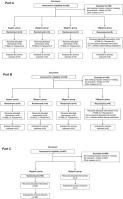重组人神经生长因子滴眼液(HT006.2.2)在健康受试者中的安全性和药代动力学
IF 4.7
3区 医学
Q1 PHARMACOLOGY & PHARMACY
引用次数: 0
摘要
背景:HT006.2.2是一种重组人神经生长因子(rhNGF)滴眼液,具有治疗神经营养性角膜炎的潜力。目的:评价HT006.2.2滴眼液在中国健康志愿者体内的安全性、免疫原性和药代动力学(PK)特性。方法:本研究分为三个部分。在A部分(单次给药)和B部分(多次给药)中,按5µg/mL、20µg/mL、60µg/mL和120µg/mL四组给药。每个剂量组包括8名受试者,按3:1的比例随机接受HT006.2.2或安慰剂。采集血清进行全身PK分析和抗药抗体(ADA)检测。C部分分为单剂量组(20µg/mL和60µg/mL),在预设时间点采集泪液样品进行泪液PK分析。计算每克泪液的药物质量(单位:µg/g)作为药物浓度,重新计算PK参数。通过生命体征监测、12导联心电图、临床实验室检查和眼科评估(眼部症状和体征、裂隙灯显微镜、角膜荧光素钠染色、眼压测量和最佳矫正视力)来评估安全性。收集研究药物初始给药后的不良事件,并将其定义为治疗出现的不良事件(teae)。结果:本研究共纳入163名受试者,其中161名受试者接受了药物治疗并按计划完成了研究。HT006.2.2在单剂量和多剂量部位均表现出良好的耐受性。最高剂量为120µg/mL时,未达到最大耐受剂量(MTD)。在不同剂量组的TEAE发生率中未发现明显的剂量-反应关系,HT006.2.2组的总TEAE发生率仍未超过安慰剂组。眼部teae包括角膜活性染料染色、眼痒、眼痛、结膜充血和视力下降。健康人外周血未检出HT006.2.2和ADA。HT006.2.2(20µg/mL)滴眼液PK分析显示,达到峰值浓度时间(Tmax)为0.17 h,平均峰值浓度(Cmax)为3.63±2.06µg/g,消除半衰期(t1/2)为4.21 h。结论:HT006.2.2滴眼液在中国健康受试者中具有良好的安全性,眼部局部分布,无全身暴露,无检测到ADAs。这些发现支持HT006.2.2在中国继续进行临床开发。本文章由计算机程序翻译,如有差异,请以英文原文为准。

Safety and pharmacokinetics of escalating doses of recombinant human nerve growth factor eye drops (HT006.2.2) in healthy subjects
Background
HT006.2.2 is a kind of recombinant human nerve growth factor (rhNGF) eye drop with the potential to treat neurotrophic keratitis.
Objective
To evaluate the safety, immunogenicity, and pharmacokinetic (PK) characteristics of HT006.2.2 eye drops in Chinese healthy volunteers.
Methods
This study was divided into three parts. In Part A (single-dose) and Part B (multi-dose), four dose groups were per-specified: 5 µg/mL, 20 µg/mL, 60 µg/mL and 120 µg/mL. Each dose group comprised eight subjects randomized in a 3:1 ratio to receive the HT006.2.2 or placebo. Serum samples were collected for systemic PK analysis and anti-drug antibody (ADA) detection. The Part C comprised two single-dose groups (20 µg/mL and 60 µg/mL), and tear samples were collected at preset time points for tear fluid PK analysis. The drug mass per gram of tears (unit: µg/g) was calculated and used as the drug concentration to recalculate the PK parameters. Safety was evaluated via vital signs monitoring, 12-lead electrocardiogram, clinical laboratory tests, and ophthalmologic assessments (ocular symptoms and signs, slit-lamp microscopy, corneal fluorescein sodium staining, intraocular pressure measurement, and best-corrected visual acuity). Adverse events were collected following the initial administration of the investigational drug and were defined as treatment-emergent adverse events (TEAEs).
Results
This study enrolled a total of 163 subjects, with 161 receiving the medication and completing the study as planned. HT006.2.2 showed favorable tolerance across both single-dose and multiple-dose parts. At the highest dose of 120 µg/mL, no maximum tolerated dose (MTD) was reached. No discernible dose-response relationship was identified in the incidence of TEAEs across dosage groups, with the total TEAE rate in HT006.2.2 groups remaining non-exceeding that of the placebo group. Ocular TEAEs included corneal vital dye staining, eye itching, eye pain, conjunctival hyperemia, and decreased visual acuity. In addition, no HT006.2.2 or ADA was detected in the peripheral blood of healthy subjects. Tear fluid PK analysis of HT006.2.2 (20 µg/mL) showed time to peak concentration (Tmax) of 0.17 h, mean peak concentration (Cmax) of 3.63 ± 2.06 µg/g, elimination half-life (t1/2) of 4.21 h.
Conclusions
HT006.2.2 eye drops exhibited favorable safety in Chinese healthy subjects, with localized ocular distribution, no systemic exposure, and no detectable ADAs. These findings support the continuation of clinical development for HT006.2.2 in China.
求助全文
通过发布文献求助,成功后即可免费获取论文全文。
去求助
来源期刊
CiteScore
9.60
自引率
2.20%
发文量
248
审稿时长
50 days
期刊介绍:
The journal publishes research articles, review articles and scientific commentaries on all aspects of the pharmaceutical sciences with emphasis on conceptual novelty and scientific quality. The Editors welcome articles in this multidisciplinary field, with a focus on topics relevant for drug discovery and development.
More specifically, the Journal publishes reports on medicinal chemistry, pharmacology, drug absorption and metabolism, pharmacokinetics and pharmacodynamics, pharmaceutical and biomedical analysis, drug delivery (including gene delivery), drug targeting, pharmaceutical technology, pharmaceutical biotechnology and clinical drug evaluation. The journal will typically not give priority to manuscripts focusing primarily on organic synthesis, natural products, adaptation of analytical approaches, or discussions pertaining to drug policy making.
Scientific commentaries and review articles are generally by invitation only or by consent of the Editors. Proceedings of scientific meetings may be published as special issues or supplements to the Journal.

 求助内容:
求助内容: 应助结果提醒方式:
应助结果提醒方式:


